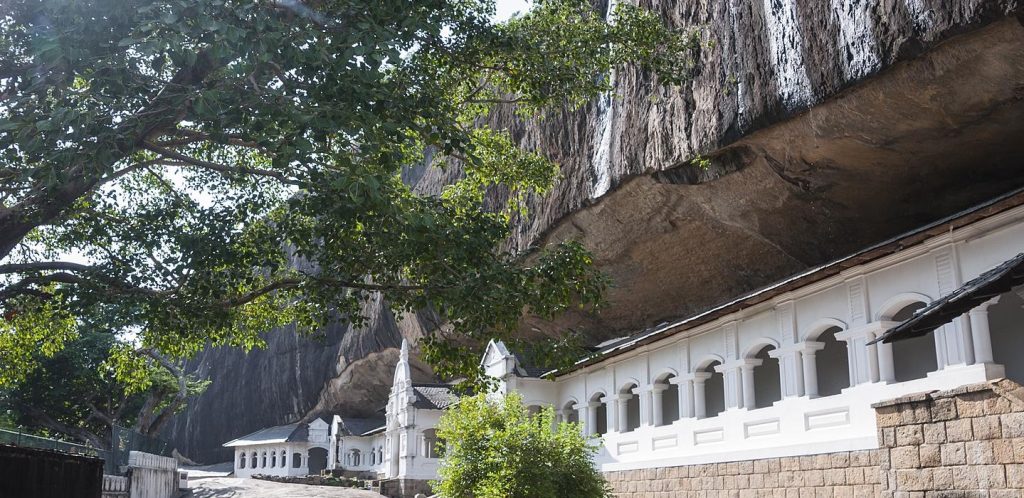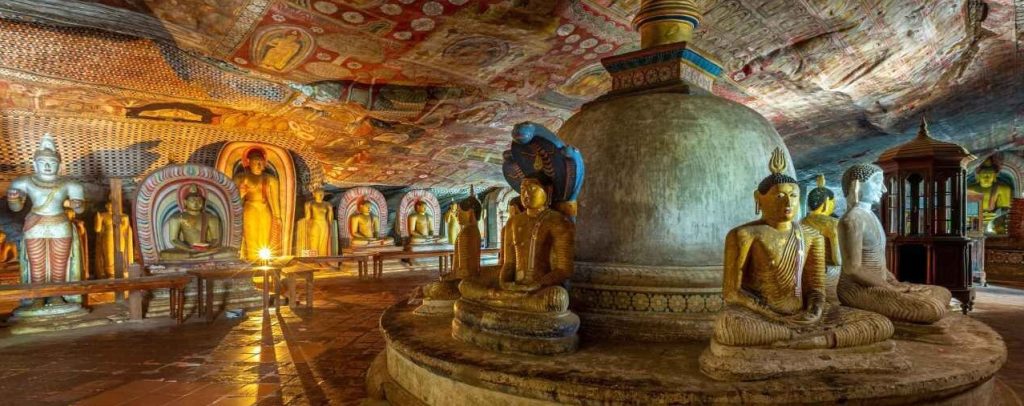
Unveiling the Magnificence of Dambulla Cave Temple – Sri Lanka’s Spiritual and Artistic Treasure
Nestled amid the emerald landscapes of Sri Lanka, the Dambulla Cave Temple, also known as the Golden Temple of Dambulla, stands as a testament to the island’s rich history, artistry, and spiritual significance. Designated as a UNESCO World Heritage Site, this extraordinary cave temple complex has a history that spans over two millennia. In this comprehensive article, we embark on a profound journey to explore the Dambulla Cave Temple, delving into its origins, historical importance, architectural splendor, spiritual essence, and practical tips for visitors.

History and Origins
The roots of the Dambulla Cave Temple can be traced back to a pivotal period in Sri Lankan history, around the 1st century BCE. King Valagamba, also known as King Vattagamani Abhaya, played a central role in the establishment and expansion of this remarkable temple complex.
During the turbulent times of King Valagamba’s reign, foreign invaders threatened the region with continuous warfare. Seeking refuge and safety, King Valagamba sought sanctuary within these natural caves. It is said that during his time in hiding, he commenced the transformation of these caves into a sacred sanctuary. Following his victorious return to the throne, the king initiated the construction of intricate rock-cut cave temples, marking the genesis of the Dambulla Cave Temple’s enduring legacy.
Architecture and Layout
The Dambulla Cave Temple is celebrated not only for its historical significance but also for its architectural brilliance and the stunning frescoes that adorn its inner sanctums. The complex consists of five main caves, each bearing its distinct charm and artistic marvels. These caves are Devaraja Viharaya, Maharaja Viharaya, Maha Alut Viharaya, Paschima Viharaya, and Devana Alut Viharaya.
- Devaraja Viharaya (Cave of the Divine King): As the largest and most awe-inspiring of the caves, Devaraja Viharaya greets visitors with a monumental 15-meter-long reclining Buddha statue carved from the natural rock. The cave’s walls are adorned with intricate paintings depicting various episodes from the Buddha’s life and exquisite depictions of Hindu deities.
- Maharaja Viharaya (Cave of the Great Kings): This cave houses an impressive ensemble of 53 standing Buddha statues, each representing a distinct posture or mudra. Its walls are graced with vibrant frescoes illustrating scenes from Buddhist mythology and the lives of ancient Sri Lankan monarchs.
- Maha Alut Viharaya (Great New Temple): Though smaller in size, Maha Alut Viharaya boasts an 8-meter-long reclining Buddha statue and paintings dating back to the Kandyan period, offering a glimpse into Sri Lanka’s rich historical tapestry.
- Paschima Viharaya (Western Temple): The fourth cave is home to an array of Buddha statues, accompanied by exquisite carvings and frescoes. It is believed to have served as a meditation chamber for Buddhist monks seeking serenity and introspection.
- Devana Alut Viharaya (Second New Temple): The smallest among the caves, Devana Alut Viharaya, features a reclining Buddha statue along with several other sacred images and inscriptions.
Each of these caves presents a unique window into Sri Lanka’s artistic and religious heritage. The painstaking craftsmanship and meticulous attention to detail evident in the cave temples are a testament to the profound devotion and skill of the ancient artisans.

Spiritual Significance
Beyond its artistic magnificence and historical value, the Dambulla Cave Temple holds profound spiritual significance for Buddhists and spiritual seekers alike. The serene ambiance within the caves, combined with the presence of ancient Buddha statues and vibrant frescoes, creates a palpable sense of tranquility and reverence.
Many visitors come here not only to marvel at the artistry but also to meditate, reflect, and seek solace from the cacophony of modern life. The cave temples exude a timeless aura, inviting all who enter to connect with their inner selves and find solace in the teachings of the Buddha.
Visiting Tips
To make the most of your visit to the Dambulla Cave Temple, consider the following practical tips:
- Modest Dress Code: As a place of worship, it is essential to dress modestly when visiting the Dambulla Cave Temple. Both men and women should cover their shoulders and knees as a sign of respect.
- Respect Temple Rules: Adhere to the temple’s rules and regulations, such as removing your shoes before entering the caves and refraining from photography inside the sacred caverns.
- Ideal Timing: The optimal times to visit the Dambulla Cave Temple are either early in the morning or late in the afternoon when the weather is more temperate, and the crowds are less dense.
Conclusion
The Dambulla Cave Temple stands as an eloquent testament to the enduring spirit of Sri Lanka’s cultural and spiritual heritage. It is a place where history, art, and spirituality converge, offering visitors a unique opportunity to connect with the past and find serenity in the present. Whether you are a history aficionado, an art enthusiast, or a seeker of spiritual wisdom, a journey to the Dambulla Cave Temple promises an enriching experience. As you explore its caves and immerse yourself in their ambiance, you will undoubtedly emerge with a profound appreciation for the profound legacy of this remarkable site. The Dambulla Cave Temple beckons, inviting you to partake in its timeless embrace and discover the essence of Sri Lanka’s spiritual and artistic heritage.


